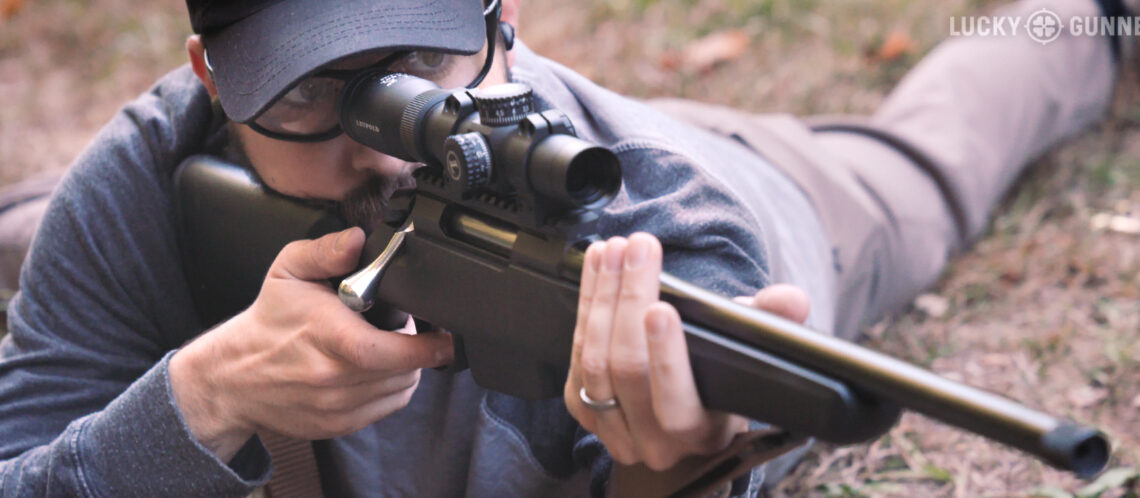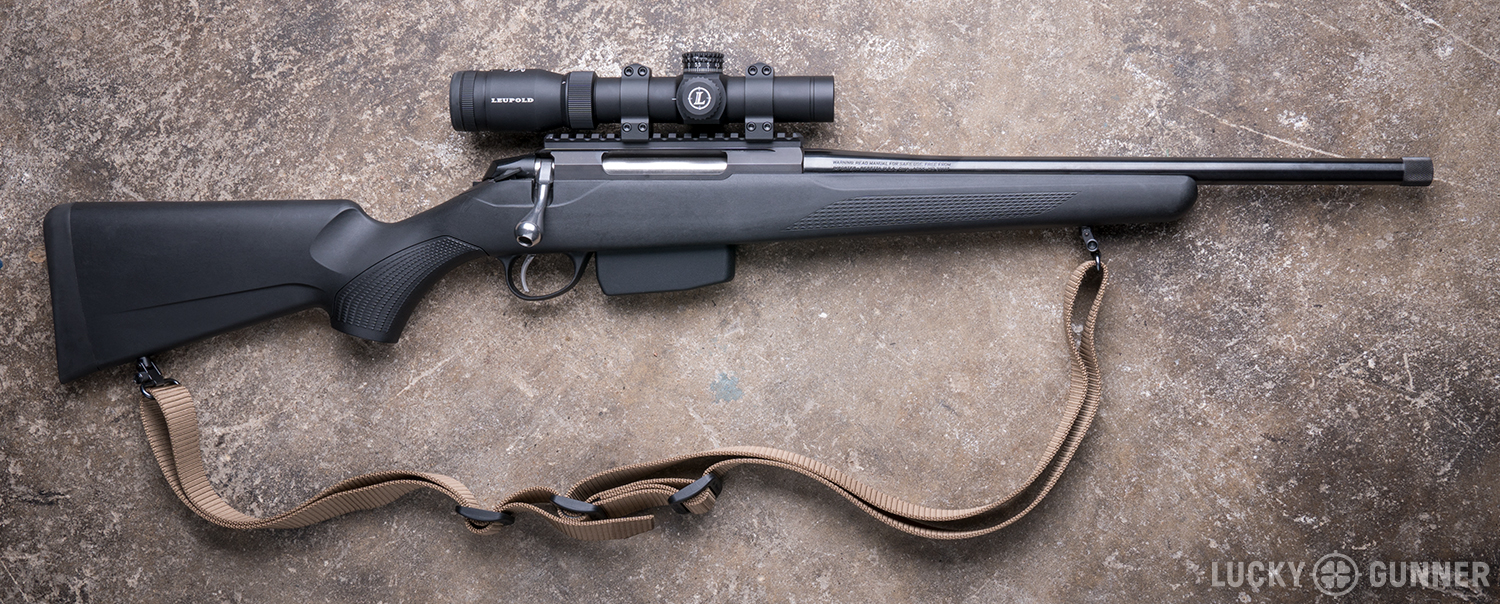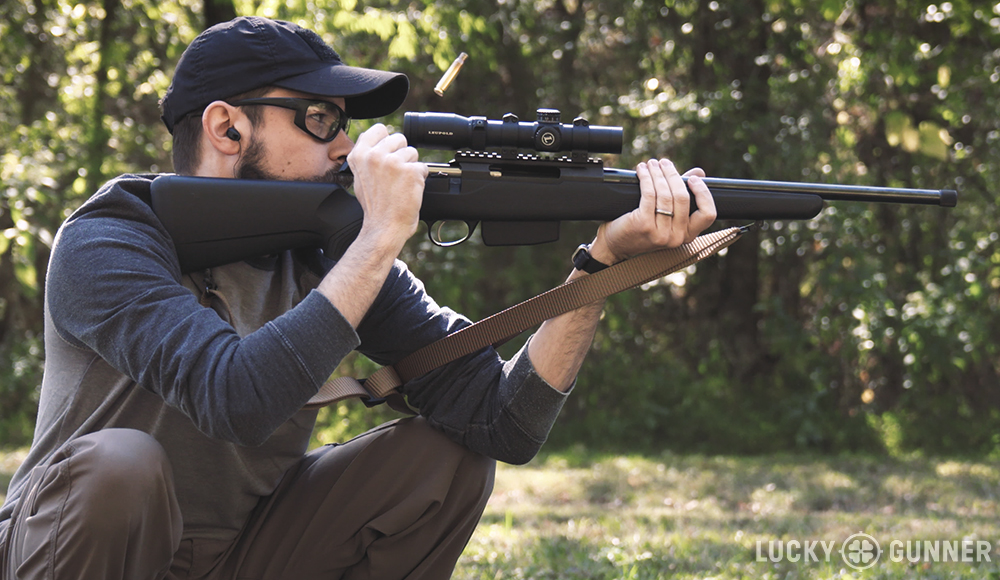And now for something completely different. For the next couple of weeks, I’m taking a break from the normal self-defense oriented topics (although there is an element of that here) to revisit a subject that’s an old favorite of mine: scout rifles. To be honest, I’ve never felt any particular need to own or build a “proper” scout rifle, but I am very much a fan of the spirit of the scout rifle concept. I really enjoy working with lightweight, handy bolt action and lever action rifles, especially when that means getting them off the bench and into the kind of field conditions that they were originally intended for. There’s certainly nothing wrong with bench rest shooting or long range precision rifle shooting, but I’ve never found much use for those pursuits beyond pure sport. However, the compact bolt action as a potential answer to the search for a general purpose practical rifle is an idea I can get behind. Details in the video with transcript following.
Full transcript below:
This is a Tikka T3x Lite Compact. It’s chambered in .308 Winchester and feeds from detachable magazines. With a Leupold VX-R Patrol scope and a Wilderness Tactical Rhodesian Sling, it weighs just 7.5 pounds loaded. This is not a scout rifle. Even though it’s a handy, lightweight, general purpose rifle, it’s missing a few of the key criteria that define a true Scout rifle. But is that such a bad thing?
Jeff Cooper’s Scout rifle concept is more popular now than it’s ever been. In the last few years, there has been a lot of discussion about scout rifles, and most of that has revolved around how we define the scout and whether the scout really is the ideal general purpose rifle. I even wrote an article along those lines myself a couple of years ago.
But instead of getting all wrapped up in critiquing and defining the Scout rifle, what if we just borrowed the best of Cooper’s ideas and used them as a starting point to put together rifles that worked for whatever our needs happen to be?
For example, a lot of people will tell you that a Scout rifle has to have ghost ring style backup iron sights, and there are some pretty compelling reasons to pursue that option. Maybe you’re out somewhere and you drop the rifle and damage the scope, or a screw comes loose and you lose your zero. If you have quick detach rings, you can just remove the scope right there and use your iron sights for the rest of the trip.
But if you decide that’s a feature you have to have, you are going to be limited to just a handful of bolt actions that come from the factory with ghost ring sights. You can have a gunsmith add iron sights to a rifle that doesn’t come with them, but that typically costs several hundred dollars. On top of that, depending on how the rear sight is installed, you might not be left with many options for where you can install a scope.
What if, instead of iron sights, you spent that money on a compact red dot optic that you carry in your backpack? If anything goes wrong with your primary scope, you just pop it off, stick the red dot on there, and you’re ready to go again with an optic that’s superior to iron sights in almost every way and it doesn’t require any costly modifications to your rifle. That solution might not work for everybody, but it’s just one example of how setting aside that preoccupation with the scout definition might allow us to consider some practical options that we would have otherwise been forced to dismiss.
There is nothing new about taking a more pragmatic approach to setting up a general purpose rifle, even among people who were once students and colleagues of Jeff Cooper himself. The scout rifle is closely related to a broader classification that some people refer to as “practical rifles”. Unlike the scout rifle, there is no official definition of the practical rifle, and I couldn’t tell you who coined the term for this specific application. But today, it is closely associated with the shooting instructor and former Gunsite staff member Randy Cain.
Randy describes the practical rifle as light and quick-handling and useful at arms reach out to 3 or 400 yards. They are usually bolt actions but can also be lever actions. They can be chambered in just about any rifle cartridge depending on the intended use, but the default choice is .308 Winchester. The preferred optics are low power variable scopes like a 1-4 or 1-6 power, or they might have non-magnified red dot sights, or iron sights.
The practical rifle is essentially the humble traditional deer rifle with special attention paid to a couple of key features to make it a slightly more flexible general purpose tool.
I should probably clarify what I mean by “general purpose” because this is another topic that comes up all the time with the Scout rifles — what “general purposes” are they actually good for besides hunting?
Well, there’s also pest control, or depending on where you live, protection from dangerous animals. The prepper community has also really embraced the idea of a low maintenance, manually operated general purpose rifle. I don’t want to speculate too much about politics or potential changes in firearm laws and I’m not going to ask you to envision some kind of post-apocalyptic Red Dawn scenario. I’ll just say this: a practical rifle can travel with you in places where an AR-15 or other semi-automatic rifle is not legal or where it might draw unwanted attention. I would not want to rely on a bolt-action rifle for home defense, but if that’s what you have available, they can be very effective for personal protection, even at close range if you have practiced that skill.
Short range engagement is one of the skills Randy Cain teaches in his Practical Rifle class. I had a chance to take this course a couple of years ago, and it was really eye-opening to learn what a quick-handling bolt gun is really capable of when you try to run it through the kind of exercises that are normally reserved for a semi-auto carbine.
And that brings me to another aspect of these discussions about scout rifles that I think demonstrates how a lot of people are completely missing the point. It’s uncommon to hear anyone talk about actually building skills with a scout rifle. It’s as if the physical characteristics of a rifle and preparing to use that rifle for any real world application are two completely separate conversations.
But obviously, those two issues are very closely related. We can guess what a particular rifle or accessory might be good for but that has limited value if we aren’t getting out there and using them. And to use them properly, we need some marksmanship and rifle handling skills — the things that make up what you might call “riflecraft.” So that is what we’re going to talk about next time.




Why even beat a dead horse? The scout rifle concept was a creature of its time, conceived by a well-respected but long dead gun instructor.
Have you actually used a “scout” or “practical” rifle, or are you just sold on the AR-15 platform to the extent that you’re simply not interested? Maybe it’s just because I’m an “older” (50) shooter, but when I’m tromping around the back country for a week and carrying everything on my back (including meat if I’m lucky) the 7 lb scout concept makes more sense than any of the other 10+ rifles I own… they are fun to shoot, easy to carry, and while not great at anything in particular, they are good at just about everything (well maybe not a 3-gun competition). 🙂
Give one a try if you haven’t. If you have and still think it’s a dumb idea from a “long dead gun instructor” then I guess you either don’t hunt the way I do, or you are a lot more tolerant of carrying heavy, high maintenance gear than I am.
Cheers!
I think given the advances in firearms since Cooper outlined the Scout Rifle philosophy, he would be much more welcoming today to many of the things we do for our “practical rifles” that depart from his original scout definition than most of the Scout Rifle “purists” would be. I dont think Cooper would be too opposed to any of the sub 8lb semi auto .308s on the market. When he developed the Scout Rifle concept, I believe the M1 Garand boat anchor was the only Battle Rifle that Americans had relatively easy access to. As for optics, I think the 1-6x illuminated reticle optic is a pretty darn good general purpose optic; nearly if not as fast as a red dot when on 1x but with up to 6x magnification. I prefer it to a scout scope for all applications except lever guns.
Ive split my “General Purpose” outdoor rifle into 2 rifles. If Im not expecting trouble and carrying all my own weight then my choice is a Marlin 336 in .30-30 with a Vortex 2-7×32 scout scope. If Im traveling in a vehicle or if I ever needed to go into a situation where I was expecting trouble, a Springfield M1A in .308 with a Vortex Strike Eagle 1-6×24 scope is my go to gun, but carrying that thing all day is no walk in the park… unless youre walking through a park.
The M14/M1A/BM-59, FAL, and HK 91 were also fairly popular battle rifles in that era. All of them very heavy and cumbersome, and not particularly accurate compared to a decent bolt action. I still don’t think the modern semi-auto .308s have quite gotten to the point where they can compete with a good practical rifle/scout rifle in terms of handiness, but there has been some progress in that direction. I would like to see a lightweight semi 308 in a “traditional” rifle form factor with no pistol grip, both for the low social profile and for ease of carry. FN had some versions of their FNAR like this, but they were still way too heavy at around 9 lbs before ammo and optics.
Did you cut the barrel to 16.5″?
Never mind I rewatched and it states it was.
I’ve been looking for a compact rifle for some time after seeing your video I looked for the tikka compact in 308
They seem too all come with 20 inch barrels, did you have yours cut down?
Yes. Mine started as a 20 inch Tikka T3x Compact and I had a local gunsmith cut it to 16.5″ and thread the muzzle. Cost was $100 and turnaround under a week. Not a difficult job for any decent gunsmith.
Are you using a T3 extended 5 round magazine in yours? Thanks.
Yes, that’s what I’m using in the video, but I also have the 3-round magazine the gun came with and it does make the rifle slightly easier to carry when not using the sling.
Cool thank you! I’ve been trying to find out whether or not the T3 magazines would work in the T3x but couldn’t find an answer anywhere online.
Have you come across any 10 round mags besides the super expensive $150 ones?
I have an old-style Remington Model 7 .308 filling this niche now. I’ve been running just with XS ghost ring and front blade, but recently acquired the Leupold 1.25-4 VX-R Patrol SPR (as in the video) and I’m waiting for a DNZ GameReaper low mount to arrive. Can’t do a fast swap to backup sight with this setup, but looks superior in most other respects.
I checked out the Tikka T3x Compact Tactical today, and WOW! Bolt action is fast and smooth, puts my Remington to shame. 10-round box and fast bolt make me think of this as a modern version of the SMLE. It’s a bit heavier than my Model 7 with its 18.5″ pencil barrel, but still passes Jeff Cooper’s “hold at arm’s length for 60 seconds without straining” test (without the scope, anyway). I’m tempted to add one to the battery.
I just recently came across this video on you tube. For some time now I’ve been interested in long range precision and was considering the RPR but after watching this video and its follow up I re-evaluated some things and decided to do something more…practical. After doing some quick research on the T3X CTR and the Savage 10 FCP I decided on the Savage FLCP since I’m a lefty.
I haven’t purchased anything yet and it may be a good thing. After reading up on practical rifle drills and needing to be able to work the bolt fast and hard I seem to remember reading a good while back that the Savage would hang if worked fast and hard.
Does anyone here know if this is still true?
Sorry to dig up an old post, This and your other story, “Becoming a Practical Rifleman” were both well done and brought a refreshed perspective. Just a quick question… What Picatinny rail did you use on the rifle. I’ve watched both videos and read the transcripts as well and didn’t see it mentioned. Thanks for the articles.
This one from Mountain Tactical: https://tikkaperformance.com/index.php?_route_=tikka-t3-optic-mounts/Tikka-T3-Performance-Series-Picatinny-Rail
Hate to resurrect and old thread, but what rings are you using with that setup?
Warne QD rings
I picked up a Mossberg MVP FLEX and never looked back. Nice and light, uses Mil magazines, and mounts the scope in a ‘normal’ position, giving me better purchase options.
I’d like to pair this exact same setup with a Dan Wesson Valor for A California-legal prepper package.